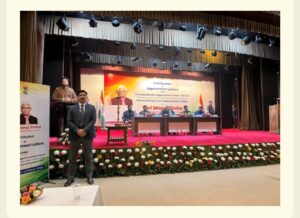India’s Chandrayaan-3 makes soft landing on lunar South Pole

India’s Chandrayaan-3’s Vikram lander has made a successful soft-landing on the moon. The country has created history by becoming the first to land on moon’s south pole.
Earlier in the day, ISRO said it is all set to initiate the Automatic Landing Sequence (ALS) for its ambitious third Moon mission Chandrayaan-3’s Lander Module (LM) to touch down on the lunar surface.
The LM comprising the lander (Vikram) and the rover (Pragyan) was scheduled to make a touch down near the south polar region of the Moon at 6:04 pm today, PTI reported.
“All set to initiate the Automatic Landing Sequence (ALS). Awaiting the arrival of Lander Module (LM) at the designated point, around 17:44 Hrs. IST (5:44 pm),” ISRO said in a post on X, formerly known as Twitter.
“Upon receiving the ALS command, the LM activates the throttleable engines for powered descent. The mission operations team will keep confirming the sequential execution of commands,” it said.
After checking all the parameters and deciding to land, ISRO will upload the required commands from its Indian Deep Space Network (IDSN) facility at Byalalu near here, to the LM, a few hours before the scheduled touchdown time.
According to ISRO officials, for landing, at around 30 km altitude, the lander enters the powered braking phase, and begins to use its four thruster engines by “retro firing” them to reach the surface of the moon, by gradually reducing the speed.
This is to ensure the lander doesn’t crash, as the Moon’s gravity will also be in play.
On reaching an altitude of around 6.8 km, only two engines will be used, while the two others will be shut down, aimed at giving the reverse thrust to the lander as it descends further, they said.
Then, on reaching an altitude of about 150-100 metres, the lander, using its sensors and cameras, would scan the surface to check whether there are any obstacles and then start descending to make a soft-landing.





